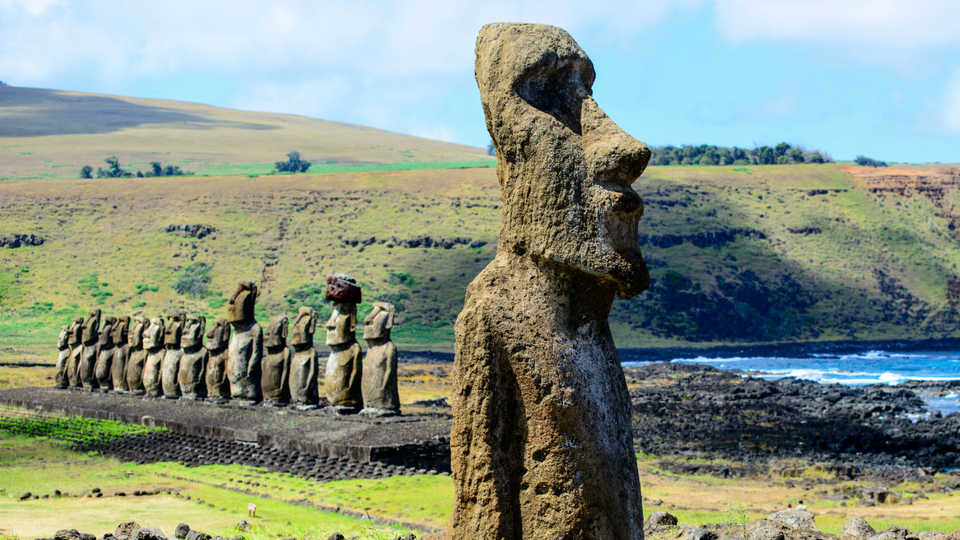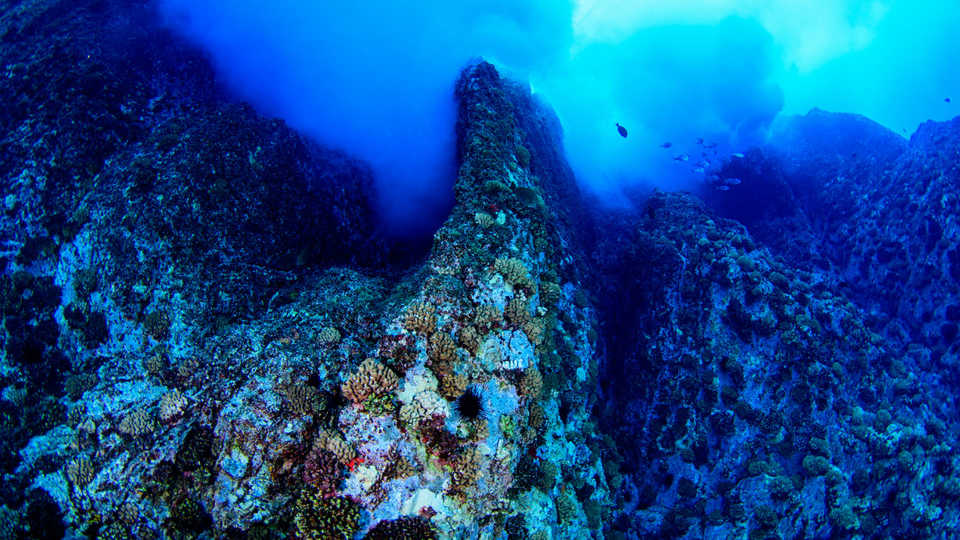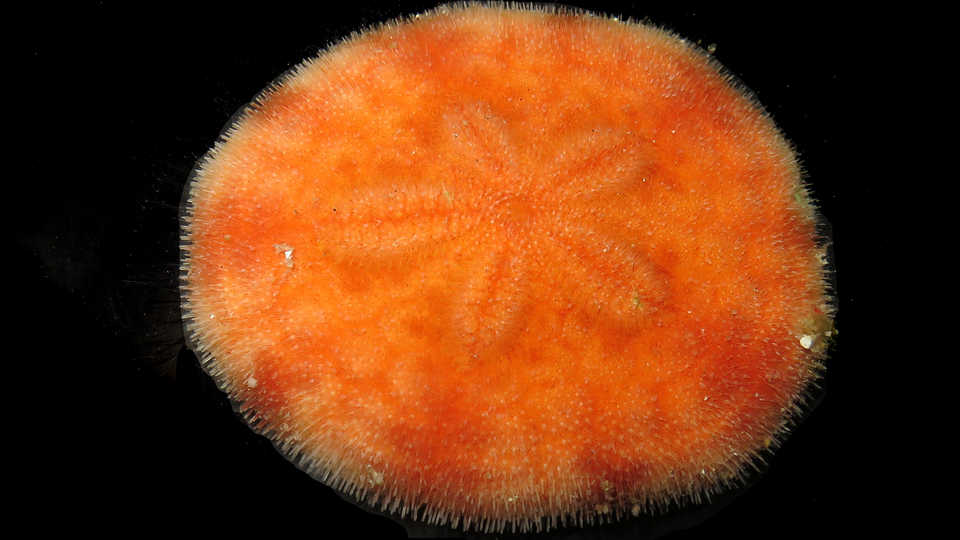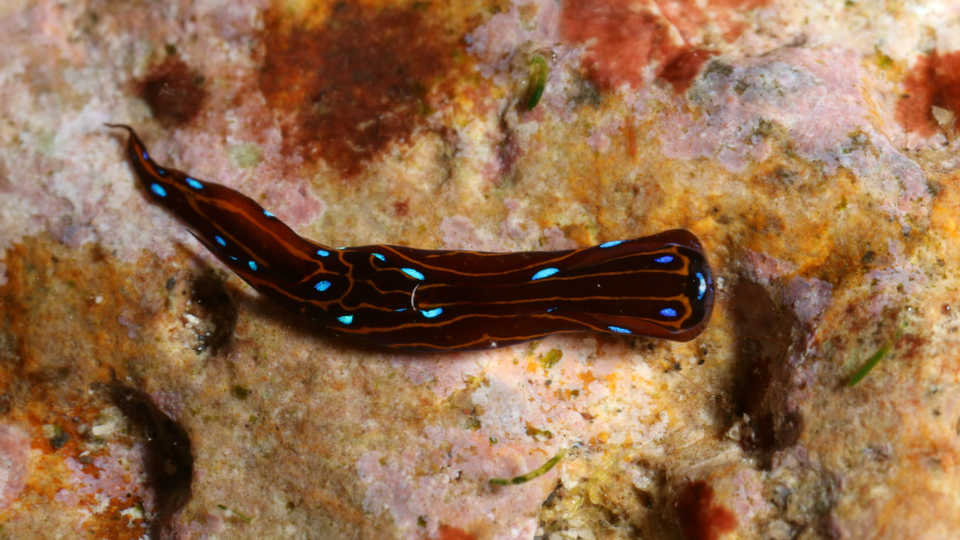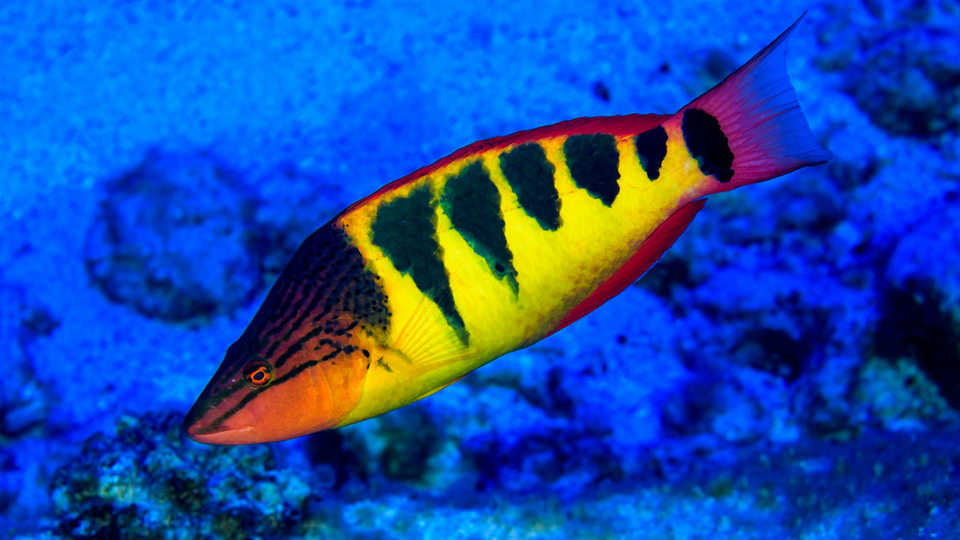Academy researchers explore Rapa Nui’s shallow reefs and make the first-ever documented dives to the region’s dimly lit “twilight zone” reefs 200–500 feet below the ocean’s surface
SAN FRANCISCO (April 3, 2017)— Last month, an extensive team of scientists from the California Academy of Sciences worked with Chilean colleagues from the Pontificia Universidad Católica de Chile (PUC) to survey the waters around Rapa Nui, an island in the Polynesian Triangle that is most well known for its mysterious stone statues. Despite a tragic history of species extinctions across the island’s iconic landscape, scientists uncovered an untold narrative beneath the waves: In this isolated marine outpost, there are still spectacular yet-to-be-discovered species that harbor exceptionally unique genetic diversity. The island’s extreme isolation and southern latitude marks the most marginal conditions in which reef ecosystems can thrive and provides an important contrast to well-studied tropical reefs.
Academy scientists surveying the region’s diversity snorkeled in the shallows, scanned steep reefs, and made history by diving to depths of 340 feet beneath the ocean’s surface to explore the dimly lit mesophotic “twilight zone,” deep reefs never before reached by divers in Rapa Nui. Extensive fieldwork yielded thrilling results: four new species of fish, one new sea biscuit, and likely several more additions to Earth’s tree of life upon further study in the coming months. The team also compiled important assessments of how coral reefs in Rapa Nui are faring in the face of unprecedented global change.
Rapa Nui marks the sixth expedition of the Academy’s recently launched Hope for Reefs initiative, with nearly $13 million raised to date for researching and restoring coral reef systems across the globe. The combined efforts of Academy scientists, local authorities, and Chilean collaborators represent a quantum leap in expanding the collective knowledge of a treasured marine ecosystem the scientific community knows very little about.
Understanding the reefs of tomorrow with Dr. Rebecca Albright
Rapa Nui boasts an incredible underwater landscape of robust coral reefs affixed atop volcanic rock. Owing to incredible water clarity, light penetrates deep into the island’s waters, allowing corals to thrive at depths upwards of 260 feet.
As one of the most isolated coral communities in the eastern tropical Pacific, Rapa Nui presented an incredible research opportunity for Dr. Rebecca Albright—Academy curator and co-leader of the Hope for Reefs initiative—who gathered firsthand assessments of hard corals while in the field.
“Rapa Nui is a very unique place to do research because it’s so remote and on the fringe of what many corals can tolerate,” says Albright, a world-renowned coral reef biologist. “Its low diversity offers a stark contrast to the warm, tropical, high diversity systems we already know so well in the western tropical Pacific like the Philippines and Micronesia.”
According to local anecdotes, the waters of Rapa Nui were once thick with algae, but in the 1980s algae declined and a marked increase in coral abundance began. Algae and corals constantly compete for dominance in reef ecosystems, so the increasing coral comprised a unique “phase shift” that swept through Rapa Nui’s waters. What triggered this phase shift, and why it benefited corals instead of algae, is a question that continues to perplex scientists. There is a lack of available ecological data to inform this region’s unique coral resurgence.
Since 2011, the Academy’s Chilean colleagues—Drs. Evie Wieters and Alejandro Pérez-Matus from the Center for Marine Conservation at PUC in Santiago—have closely monitored water temperature as part of their research on quantifying changes in reef fishes and coral communities. A steadily warming trend has proven tolerable for the corals but suppressed algal growth—the main attractor for local fish, which have also suffered from centuries of intensive harvest. Today, Rapa Nui’s reefs are relatively devoid of fish compared with their tropical reef counterparts.
Two species dominate the majority of coral coverage in Rapa Nui: Pocillopora verrucosa and Porites lobata. These resilient reef-building groups thrive across tropical and subtropical locations in both crystalline and murky waters. “These species are scrappy,” says Albright, noting that they can persist where other corals decline if faced with fluctuations in water quality, ocean temperature, and acidity. “We want to understand what enables these genera to thrive in conditions where most other coral species can’t live.”
“Because Pocillopora and Porites live across the extremes,” she explains further, “understanding the marginal environment in which they thrive in Rapa Nui—and their capacity to locally adapt to changing conditions—may help us understand what future reefs, potentially dominated by these genera, could look like.”
Albright has been collecting genetic samples of these two genera of reef-building corals across the Western Pacific to monitor population structure and connectivity between reefs. Rapa Nui provides critical data for the easternmost, isolated point in their vast geographic range across the Pacific.
Sleuthing sea urchins in the shallows
“Rapa Nui is so remote, it’s hard for anything to get there, whether you are a human or a tiny larva drifting the high seas,” says Dr. Rich Mooi, Academy Curator of Invertebrate Zoology and Geology and sea urchin expert. “If larvae do ride the currents this far, they often evolve into something new. That’s what makes this place so exciting—when you do find something that made it to Rapa Nui, it’s often unlike anything else on Earth.”
Before his arrival, Mooi found the one and only paper written in the 1970s about sea urchins of Rapa Nui. “I had an inkling of what might be here,” he recalls, “but on every expedition we seek to explore beyond what we already know.” Mooi discovered a species entirely new to science and also found a few known urchins that had never been documented on the island before.
Collaborator Tyler Phelps, a skilled scientific diver and undergraduate at the University of Hawaii at Hilo, collected a bright orange sea biscuit—a sand-burrowing relative of urchins—from a depth of 250 feet belonging to the genus Clypeaster. Mooi immediately knew the sea biscuit was entirely new to science because of its unusually deep habitat and vibrant orange color uncharacteristic of all other Clypeaster species.
Mooi snorkeled in the shallows and soon found an urchin species known only to occur on Rapa Nui chewing into the coral-laden lava rock below. The deep purple urchin hails from the genus Echinometra, the most common group of urchins in the world found on every shore except Antarctica. “I knew I’d find Echinometra here, but I wasn’t expecting it to look so different! I was shocked by the striking magenta color that sets it apart from all other members of the genus.”
Even larger, easy-to-find sea urchins can bring surprises. Pseudoboletia is a genus of medium-sized urchins that self-adorn with small pieces of coral and live throughout the Indo-Pacific. Mooi and his colleagues found specimens of this group—measuring nearly half a foot across—that bear no resemblance to known species. He suspects that research in the coming months will likely reveal the Rapa Nui individuals to represent a new species entirely.
Less common is Lissodiadema, an urchin with fine, bendable spines that lives inside caves and beneath rocks. Although rarely spotted in the field, Academy colleague and veteran invertebrate zoology curator Dr. Terry Gosliner collected one from a shallow reef that seems to also represent a separate species from its close yet cryptic Philippine relative.
“We already know terrestrial species have been heavily impacted in Rapa Nui,” says Mooi. Since the beginning of human occupation nearly 12 centuries ago, native flora and fauna on the island—including a variety of marine birds and a massive endemic palm—suffered catastrophic decline until their complete or almost complete disappearance. “But there’s a positive side to this coin—with every new species discovered, we are helping to show that it’s not too late to understand and protect the marine environment.”
Solving sea slug mysteries
More than ten years ago, Academy Curator of Invertebrate Zoology and Geology Dr. Terry Gosliner ventured to Rapa Nui where he discovered a new species of sea slug—vibrant invertebrates made famous by their poisonous adaptations and importance to biomedical research—slinking along in the shallows. One of more than one thousand nudibranchs described by Gosliner, the speckled resident—named Chelidonura alisonae—has a range that extends as far as the Hawaiian Islands.
“I was really pleased to find Chelidonura alisonae again in Rapa Nui so that I could obtain critical molecular samples,” says Gosliner. He plans to run genetic testing on new specimens at the Academy’s Center for Comparative Genomics to ensure the Rapa Nui sea slug and its Hawaiian counterpart are indeed the same—or else reveal a new species entirely.
Gosliner also revisited an orange sea slug he observed during his first visit to Rapa Nui—a creature previously believed to have ranged broadly across the Pacific. Upon closer examination, Gosliner realized there were more than a dozen separate species inhabiting their own geographic ranges. “Now I’m wondering if we’ve also overlooked the sea slug here in Rapa Nui as a new species. Having collected it on this trip, I’m happy to finally answer that question once and for all.”
“So while we’re closing the loop on two mysteries, I’m surprised we didn’t find more nudibranch diversity,” Gosliner says. “That doesn’t mean more aren’t here, it just means we haven’t found them yet. There’s still so much to be discovered.” Gosliner and other marine invertebrate experts at the Academy will take a close look in the coming months at a cowry snail, sea stars, and a sea anemone collected during the expedition to assess whether they, too, might be new to science.
First-ever dives to Rapa Nui’s twilight zone reefs
The Academy’s scientific dive team made history as the first divers to ever explore the twilight zone—mysterious reefs thriving at depths between 200 and 500 feet—on the island of Rapa Nui. Here animals live in partial darkness, well beyond recreational diving limits yet above the deep trenches patrolled by submarines and ROVs. Reaching extreme depths requires Academy divers to push the boundaries of both technology and the human body, using closed-circuit "rebreathers" that extend the amount of time they can spend underwater.
The research team—led by Academy Ichthyology Curator Dr. Luiz Rocha and Steinhart Aquarium Director Bart Shepherd, both co-leaders of the Hope for Reefs initiative—spent each day scouting and diving the narrow band of deep reefs that surround the island. The team logged a maximum depth of 340 feet and made many critical observations of twilight fauna.
“No one has been to the twilight zone in Rapa Nui, so we have no understanding of the evolutionary origins of these deep, endemic species,” says Rocha, a global expert in coral reef fishes. Typically, fish species prefer either the shallows or the dark twilight zone, but in Rapa Nui, Rocha observed that many fishes exist across a wide depth range.
“The clarity of Rapa Nui’s water allows the sun to penetrate and stimulate coral and algal growth at greater depths,” Rocha explains. “Fish that feed on the coral and algae then follow their food sources deeper.” Similarly, temperature also shows uniformity across the water column during the wintertime, which invites traditionally shallow species to follow the thermal gradient to deeper waters.
Rocha concluded the expedition with four new fish species and plans to give them all Rapa Nui names in honor of the local culture. Rocha recognized one of the new species from recent ROV photos that captured a yellow-finned fish new to science. During the last dive of the expedition, Rocha spotted it darting through the depths at 340 feet. Other fish species proved difficult to catch, such as the new Plectranthias species, a very cryptic fish that likes to hide in caves and under rocks, skillfully collected by Shepherd.
“It’s important to understand how the ecosystem works here because it’s the lowest diversity of species you’ll find in any coral reef across the Pacific,” says Rocha. Rapa Nui’s low diversity represents the minimum level of trophic complexity—or levels of predator-prey interactions in the food chain—that can be sustainable. “If one link in the chain breaks here, everything collapses. We’re trying to learn more to prevent that from happening.”
In contrast to Academy research sites in the Philippines, considered to be the center of the center of marine biodiversity, Rapa Nui ecosystems face greater impacts when species disappear.
“Rapa Nui’s low diversity means it’s already more vulnerable to global change than most reefs,” says Rocha, “but we might be able to use this amazing region to predict how other global reefs might fare when faced with massive reductions in species. How does this incredible system function with so few players? We hope to find out.”
Not too late for Rapa Nui reefs
This expedition to Rapa Nui—the sixth trip in the Academy’s new push to explore, explain, and sustain global reefs—is a positive step towards understanding little-known reefs worldwide. The Academy has a long history of exploring marine biodiversity in tropical reefs, and the opportunity to explore subtropical Rapa Nui provides a critical contrast to the team’s prior research.
“We were thrilled by the opportunity to work so closely with our Chilean colleagues and the Rapa Nui people,” says Gosliner, who hopes the team returns in the future. “Our research never ends, and we hope to deepen our relationships with local collaborators as our work gains momentum in the coming years,” adds coral-expert Albright.
Expedition discoveries will be confirmed and described in the coming months as Academy scientists use DNA sequencing and other tools to analyze all specimens collected in the field, likely discovering even more new species in the process. Their work will be available for further study by the scientific community.
“New species discoveries in Rapa Nui show that there are still reservoirs of genetic uniqueness worth saving, just like the moai statues so iconic to the landscape,” says Mooi. “Hopefully our new data can play a part in helping the Rapa Nui people sustain the special waters to which their cultural heritage is so intricately tied.”
The Academy's international research efforts are made possible by partners in Rapa Nui, Chile, and the United States. Partners actively participate in planning, logistical support, and execution of several facets of each expedition. The Academy gratefully acknowledges partners and collaborators for its 2017 expedition, listed below.
Chile:
Center for Marine Conservation at the Pontificia Universidad Católica de Chile
Rapa Nui:
The Academy's Hope for Reefs initiative is made possible through the support of visionary donors. The Academy gratefully acknowledges the lead partners listed below.
- William K. Bowes, Jr. Foundation
- Dalio Ocean Initiative
- Eva and Bill Price
- Jennifer Caldwell and John H. N. Fisher
- Wendy and Eric Schmidt
The Institute for Biodiversity Science and Sustainability at the California Academy of Sciences is at the forefront of efforts to understand two of the most important topics of our time: the nature and sustainability of life on Earth. Based in San Francisco, the Institute is home to more than 100 world-class scientists, state-of-the-art facilities, and nearly 46 million scientific specimens from around the world. The Institute also leverages the expertise and efforts of more than 100 international Associates and 400 distinguished Fellows. Through expeditions around the globe, investigations in the lab, and analysis of vast biological datasets, the Institute’s scientists work to understand the evolution and interconnectedness of organisms and ecosystems, the threats they face around the world, and the most effective strategies for sustaining them into the future. Through innovative partnerships and public engagement initiatives, they also guide critical sustainability and conservation decisions worldwide, inspire and mentor the next generation of scientists, and foster responsible stewardship of our planet.
Press Contacts
If you are a journalist and would like to receive Academy press releases please contact press@calacademy.org.
Digital Assets
Hi-res and low-res image downloads are available for editorial use. Contact us at press@calacademy.org to request access.
